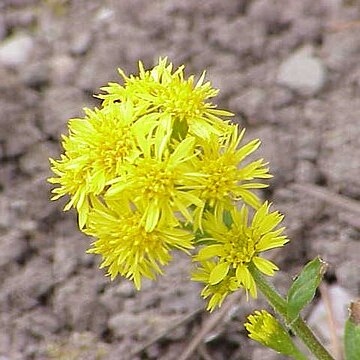Heads radiate, the rays pistillate and fertile, yellow or in 2 spp. white; invol bracts usually ± imbricate in several series, chartaceous at base, commonly with ± herbaceous green tip; receptacle small, flat or a little convex, alveolate, naked or seldom with a few phyllary-like bracts near the margin; disk-fls perfect and fertile, yellow, seldom more than 25(–60); style-branches flattened, with lanceolate, externally hairy appendage; achenes several-nerved, subterete or angled; pappus of numerous equal or sometimes unequal, capillary (in one sp. short and firm) bristles, usually white; fibrous-rooted perennial herbs with simple, alternate, entire or variously toothed lvs and few to many, mostly rather small, campanulate to subcylindric heads; x=9. Nearly 100, mainly N. Amer. (Oligoneuron, Unamia) Hybrids are often found. All our spp. bloom in mid-or late summer and fall, S. juncea being one of the earliest, and S. speciosa one of the latest. Several spp. may have one or two B-chromosomes in addition to the number given.Goldenrods can be divided into several groups on the basis of three sets of characters that are independently distributed with respect to each other: the nature of the underground parts, the nature and distribution of the lvs, and the nature of the infl. Several terms explained below are used without further comment in the key and descriptions. In many spp. the rhizome is very short, stout, and densely rooting, sometimes being more nearly a caudex than a proper rhizome. Such spp. often have several stems clustered together, although the stems may also be solitary. In other spp. the rhizome is elongate and generally more slender, and the stems are usually scattered. Some few spp. have both a short, stout rhizome or caudex and more elongate, slender, sometimes stoloniform rhizomes.In many spp. the lvs are basally disposed. The radical and lowermost cauline lvs are relatively large and usually ± persistent, with the blade either gradually or abruptly contracted to a definite petiole. The cauline lvs (either numerous or often few) are progressively reduced and less petiolate upward, those near and above the middle of the stem usually being sessile or nearly so and of different shape from those below, often relatively as well as actually narrower. In other spp. the lvs are chiefly cauline. The radical lvs are small and relatively inconspicuous, or more often wanting. The lowermost cauline lvs are reduced and generally soon deciduous, so that the stem appears to be naked toward the base at flowering time. The largest leaves are somewhat above the base but evidently below the middle of the stem. The middle and upper lvs are gradually reduced but essentially similar in shape to the larger ones. Most spp. of this group have numerous, sessile or sub sessile lvs. A few spp. fall between the two habit types, or range from one to the other. Measurements of lf-length in the descriptions include the blade and petiole, unless only the blade is specified.Infls are mostly of 3 general types. In one group the heads are in axillary clusters or in a terminal, ± elongate thyrse that is straight, cylindrical, and not at all secund, or the infl consists of several such thyrsoid branches. In another group the infl is paniculiform, with at least the lower branches recurved-secund, or is slender and elongate (sometimes racemiform) and ± one-sided, or at least nodding at the tip. In a third group the infl is short and broad, flat or round-topped, but not at all secund, and is said to be corymbiform.
More
Usually perennial herbs, rarely shrubs. Lvs alternate, simple, entire or serrate. Capitula several to numerous in racemose or corymbose panicles. Involucral bracts in 3-several rows, imbricate, mostly chartaceous. Receptacle flat or convex; scales usually 0, sometimes few. Outer florets ♀, usually ligulate, very rarely filiform, often as many as or more than disc florets, usually in 1 row; ligules yellow. Inner florets ☿, tubular. Achenes all similar, obovoid to cylindric, terete or angled, ribbed, glabrous or hairy; pappus of scabrid hairs in 1 row.

